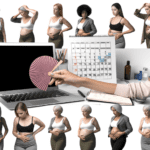Understanding Ovarian Reserve
The concept of ovarian reserve refers to the pool of eggs present in a woman’s ovaries at any given time. This reserve is a critical factor in female fertility, influencing both the ability to conceive and the timing of menopause. Unlike men, who produce sperm continuously, women are born with a finite number of eggs. This number peaks before birth, declines with age, and represents the potential for reproduction over the course of a woman’s life.
Egg Count at Birth
At birth, a female infant typically has between 500,000 to 1 million primordial follicles, each containing an immature egg. This number is the highest it will ever be, as women do not generate new eggs during their lifetime. The follicles are in a dormant state until puberty, when they begin to mature and be released during the menstrual cycle.
Decline of Egg Quantity and Quality Over Time
As a woman ages, the quantity and quality of her eggs diminish in a process that is both natural and inevitable. By the onset of puberty, the number of follicles drops to approximately 400,000, and with each menstrual cycle, dozens of follicles are lost while typically only one reaches full maturity and is ovulated. By the time a woman reaches her mid-30s, the decline accelerates, and by her late-30s, fewer than 50,000 may remain. This decline is not only quantitative but also qualitative, as the genetic integrity of eggs deteriorates over time.
Importance of Egg Quality in Fertility
The quality of eggs is paramount in fertility. High-quality eggs have a better chance of being fertilized and developing into healthy embryos. As women age, the likelihood of chromosomal abnormalities in eggs increases, which can lead to difficulties in conception, higher rates of miscarriage, and an increased risk of genetic disorders in offspring. Therefore, while the number of eggs is a key aspect of ovarian reserve, the quality of these eggs is equally, if not more, crucial in determining reproductive potential.
Biological Mechanisms of Egg Maturation
Role of the Hypothalamus and Hormones
The maturation of eggs, or oocytes, is a complex process regulated by the hypothalamus and various hormones. The hypothalamus, a region of the brain, plays a pivotal role by secreting gonadotropin-releasing hormone (GnRH). GnRH stimulates the anterior pituitary gland to release follicle-stimulating hormone (FSH) and luteinizing hormone (LH), which are directly involved in the growth and maturation of ovarian follicles. FSH promotes the growth of follicles, while LH triggers ovulation, the release of a mature egg from the dominant follicle.
The Follicular and Ovulation Phases
The ovarian cycle consists of the follicular phase, ovulation, and the luteal phase. During the follicular phase, FSH encourages the growth of several follicles, each containing an immature oocyte. Typically, one follicle becomes dominant and continues to mature, while the others undergo atresia. The ovulation phase is marked by a surge in LH levels, leading to the release of the mature egg from the dominant follicle. This egg is now ready for potential fertilization.
Factors Influencing Egg Loss
- Atresia: Throughout a woman’s reproductive life, the majority of follicles undergo atresia, a process of programmed cell death, which significantly reduces the ovarian reserve.
- Hormonal Fluctuations: Imbalances in hormones such as FSH and LH can affect the growth and survival of follicles, influencing the number of eggs available for maturation.
- Age: As a woman ages, the quality and quantity of her oocytes decline, leading to a decrease in fertility. This is due to factors such as chromosomal abnormalities and reduced ovarian reserve.
- Lifestyle Factors: Smoking, excessive alcohol consumption, and certain medications can negatively impact egg quantity and quality.
- Genetic Factors: Genetic predispositions can influence the rate of follicular atresia and the overall health of oocytes.
In summary, the maturation of eggs is a finely tuned process influenced by the hypothalamus, hormones, and various intrinsic and extrinsic factors. Understanding these mechanisms is crucial for addressing fertility issues and developing assisted reproductive technologies.
Fertility Across Different Life Stages
Puberty and Menstrual Cycle Onset
The journey of a woman’s fertility begins at puberty, which marks the onset of her menstrual cycle. Puberty typically starts between the ages of 8 and 13, with the average age of menstruation onset around 12 to 13 years. At this stage, a female has approximately 300,000 to 500,000 eggs. The hypothalamus triggers the release of gonadotropin-releasing hormone (GnRH), which in turn stimulates the production of follicle-stimulating hormone (FSH) and luteinizing hormone (LH). These hormones are crucial for the development and release of mature eggs during the menstrual cycle.
Fertility Peak and Decline in the 20s and 30s
Women experience their peak fertility in their mid-20s, with a 25–30% chance of conceiving each month. As women enter their 30s, fertility begins to decline gradually. By the age of 32, the decline becomes more pronounced, and by 37, it accelerates rapidly. At 30, a woman may have around 72,000 eggs, but by 40, this number drops to about 18,000. The chances of natural conception also decrease, with a 20% chance of conceiving per cycle in the early 30s and a significant reduction thereafter.
Fertility and Egg Count Approaching Menopause
Approaching menopause, a woman’s egg count and quality continue to diminish. By the time a woman reaches menopause, typically around the age of 51, she may have fewer than 1,000 eggs left. The decline in egg quantity is accompanied by a decrease in egg quality, with older eggs more likely to have chromosomal abnormalities. This decline in both quantity and quality contributes to the increased risk of infertility, miscarriage, and chromosomal disorders in offspring as a woman ages. The transition to menopause signifies the end of a woman’s reproductive years, as the ovaries cease to release eggs and estrogen levels decline.
Impact of Age on Egg Quality
Chromosomal Abnormalities in Older Eggs
As women age, the quality of their eggs often declines, a phenomenon that can be attributed to chromosomal abnormalities. These abnormalities become more prevalent in the eggs of older women due to the deterioration of the cellular machinery responsible for maintaining the correct chromosome number during cell division. The process of cell division, known as meiosis, becomes less efficient with age, leading to an increased likelihood of errors. Eggs with an abnormal number of chromosomes are referred to as aneuploid, and the incidence of aneuploidy rises from 10% to 25% in women in their early 30s to over 50% in women over 40.
Aneuploid eggs are less likely to result in a successful pregnancy and are more likely to lead to miscarriages or chromosomal disorders in offspring, such as Down syndrome. The risk of miscarriage also increases with maternal age, with studies indicating that women under 30 have a 5% chance of miscarriage, which escalates to 16% for women aged 35-39, and to 60% for women aged 44-46.
Risks Associated with Advanced Maternal Age
Advanced maternal age, typically defined as 35 years and older, carries increased risks for both the mother and the baby. For the mother, these risks include a higher chance of developing gestational diabetes, preeclampsia, and complications during delivery. For the baby, the risks include preterm birth, low birth weight, and chromosomal abnormalities.
Women of advanced maternal age are also more likely to experience fertility issues due to the diminished quantity and quality of their eggs. This can make natural conception more challenging and may lead to an increased reliance on assisted reproductive technologies (ART) such as in vitro fertilization (IVF). Even with IVF, the success rates decline with age, particularly after the age of 40. Technological advancements like preimplantation genetic testing (PGT) can help identify genetically normal embryos, thereby improving the chances of a successful pregnancy and reducing the risk of miscarriage.
For women approaching or in their mid- to late 40s, finding genetically normal eggs during IVF can be increasingly difficult. In such cases, healthcare providers may recommend egg or embryo donation as a more viable option for achieving pregnancy.
In conclusion, age is a significant factor affecting egg quality, with older eggs being more prone to chromosomal abnormalities and associated risks. Women considering pregnancy later in life should be aware of these factors and may wish to discuss their reproductive options with a healthcare professional.
Assessing Ovarian Reserve
Antral Follicle Count Test
The Antral Follicle Count (AFC) Test is a vital ultrasound-based assessment used to estimate a woman’s ovarian reserve. This test involves counting the visible follicles within the ovaries, typically those measuring between 2-10mm, during the early follicular phase of the menstrual cycle. The AFC provides a snapshot of the quantity of a woman’s remaining egg supply, as each antral follicle contains an immature egg that has the potential to mature and ovulate.
Performed by a skilled sonographer, the AFC is considered a reliable predictor of how a woman might respond to ovarian stimulation in fertility treatments such as in vitro fertilization (IVF). A higher count suggests a greater ovarian reserve and potentially a better response to stimulation, while a lower count may indicate diminished ovarian reserve. However, it’s important to note that the AFC can fluctuate and may overestimate the number of follicles capable of responding to fertility treatments, as it includes both healthy and atretic (deteriorating) follicles.
Anti-Mullerian Hormone (AMH) Test
The Anti-Mullerian Hormone (AMH) Test is a blood test that measures the levels of AMH produced by the granulosa cells of the ovarian follicles. AMH serves as a marker of the ovarian reserve, reflecting the quantity of a woman’s remaining egg supply. Unlike the AFC, AMH levels are relatively stable throughout the menstrual cycle and can be measured at any time, providing a convenient and consistent indicator of ovarian reserve.
AMH levels naturally decline with age, correlating with the decrease in both the quantity and quality of the eggs. This test is particularly useful for predicting ovarian response to stimulation in fertility treatments, with lower AMH levels suggesting a reduced ovarian reserve and a potential for a lower response to stimulation. Conversely, higher AMH levels are generally associated with a better response to fertility drugs and a greater number of eggs retrieved during IVF cycles.
It is crucial to interpret AMH levels in conjunction with other factors such as age, as they do not directly predict the ability to conceive naturally. While a low AMH level may indicate a lower ovarian reserve, it does not necessarily mean that pregnancy is impossible. Similarly, a high AMH level does not guarantee successful conception, as it does not assess egg quality or other factors that contribute to fertility.
In summary, both the Antral Follicle Count and Anti-Mullerian Hormone tests are essential tools for assessing ovarian reserve. They provide valuable information for individuals and couples considering fertility treatments and can help guide clinical decisions. However, they should be used as part of a comprehensive fertility evaluation, considering the full spectrum of factors that influence reproductive health and the potential for conception.
Fertility Preservation and Assisted Reproductive Technologies
Egg Donation and Its Process
Egg donation is an invaluable option for individuals who are unable to conceive using their own eggs. This may be due to premature ovarian failure, diminished ovarian reserve, or genetic concerns. The process involves a donor, often a younger woman, undergoing ovarian stimulation to produce multiple eggs. These eggs are then retrieved and fertilized in a laboratory setting, typically with sperm from the intended parent or a sperm donor. The resulting embryos can be transferred to the recipient’s uterus or a gestational carrier. Egg donation requires careful coordination, legal agreements, and ethical considerations, ensuring that all parties’ rights and responsibilities are clearly outlined.
Egg Freezing for Future Use
Egg freezing, or oocyte cryopreservation, is a method of fertility preservation that allows women to store their eggs for future use. This is particularly appealing for those who wish to delay childbearing due to career, education, or the absence of a partner. The process involves hormonal stimulation of the ovaries, followed by egg retrieval and freezing. Eggs are stored in liquid nitrogen, maintaining their viability for years. When the woman is ready to conceive, the eggs are thawed, fertilized with sperm, and the resulting embryos are transferred to the uterus. Egg freezing offers autonomy over reproductive choices but also requires careful consideration of the potential emotional, financial, and ethical implications.
Advanced Fertility Treatments
For individuals facing infertility, advanced fertility treatments such as In Vitro Fertilization (IVF) and Intrauterine Insemination (IUI) can offer hope. IVF involves stimulating the ovaries to produce multiple eggs, retrieving these eggs, and fertilizing them with sperm in a lab. The embryos are then transferred to the uterus. IUI is less invasive, involving the direct insertion of sperm into the uterus around the time of ovulation to facilitate fertilization. Both treatments can be used with donor sperm or eggs if needed. While these technologies have opened doors for many, they also come with considerations regarding the physical and emotional toll, as well as the financial investment involved.
Fertility Considerations for Transgender and Nonbinary Individuals
Egg Freezing Before Transition
For transgender men and nonbinary individuals assigned female at birth (AFAB), fertility preservation is a critical consideration before undergoing gender-affirming treatment. Egg freezing, or oocyte cryopreservation, is a viable option for those who may wish to have biological children in the future. The process involves ovarian stimulation to produce multiple eggs, which are then retrieved and frozen for later use. It is recommended to undergo this procedure before starting hormone therapy, as testosterone can affect ovarian function and egg quality. The decision to freeze eggs can be complex, involving emotional, financial, and medical considerations, but it provides a pathway to biological parenthood that might otherwise be closed by transition-related treatments.
Effects of Testosterone on Fertility
Testosterone therapy, commonly used by transgender men and nonbinary individuals for masculinization, can have significant effects on fertility. While testosterone may lead to amenorrhea and cessation of ovulation, its impact on fertility is not always permanent. Some individuals may retain the ability to become pregnant even after starting testosterone, though the likelihood decreases over time. It is important to note that testosterone is not a form of contraception, and the possibility of pregnancy exists if the individual has unprotected sex with a partner capable of producing sperm. For those wishing to conceive after starting testosterone, cessation of hormone therapy and a period of menstrual cycle normalization may be required. However, the effects of long-term testosterone use on fertility are not fully understood, and more research is needed.
Fertility Guidance and Research Needs
Transgender and nonbinary individuals seeking fertility preservation or conception face unique challenges and a lack of tailored guidance. Healthcare providers must offer inclusive and affirming care, providing comprehensive information on fertility options and the potential impacts of gender-affirming treatments. Current research on the long-term effects of testosterone on AFAB fertility is limited, and more studies are needed to provide evidence-based recommendations. Additionally, there is a need for improved access to fertility services and insurance coverage for fertility preservation for transgender and nonbinary individuals. As societal understanding and medical technology advance, it is crucial that fertility options evolve to support the diverse needs of all individuals seeking to build their families.

















